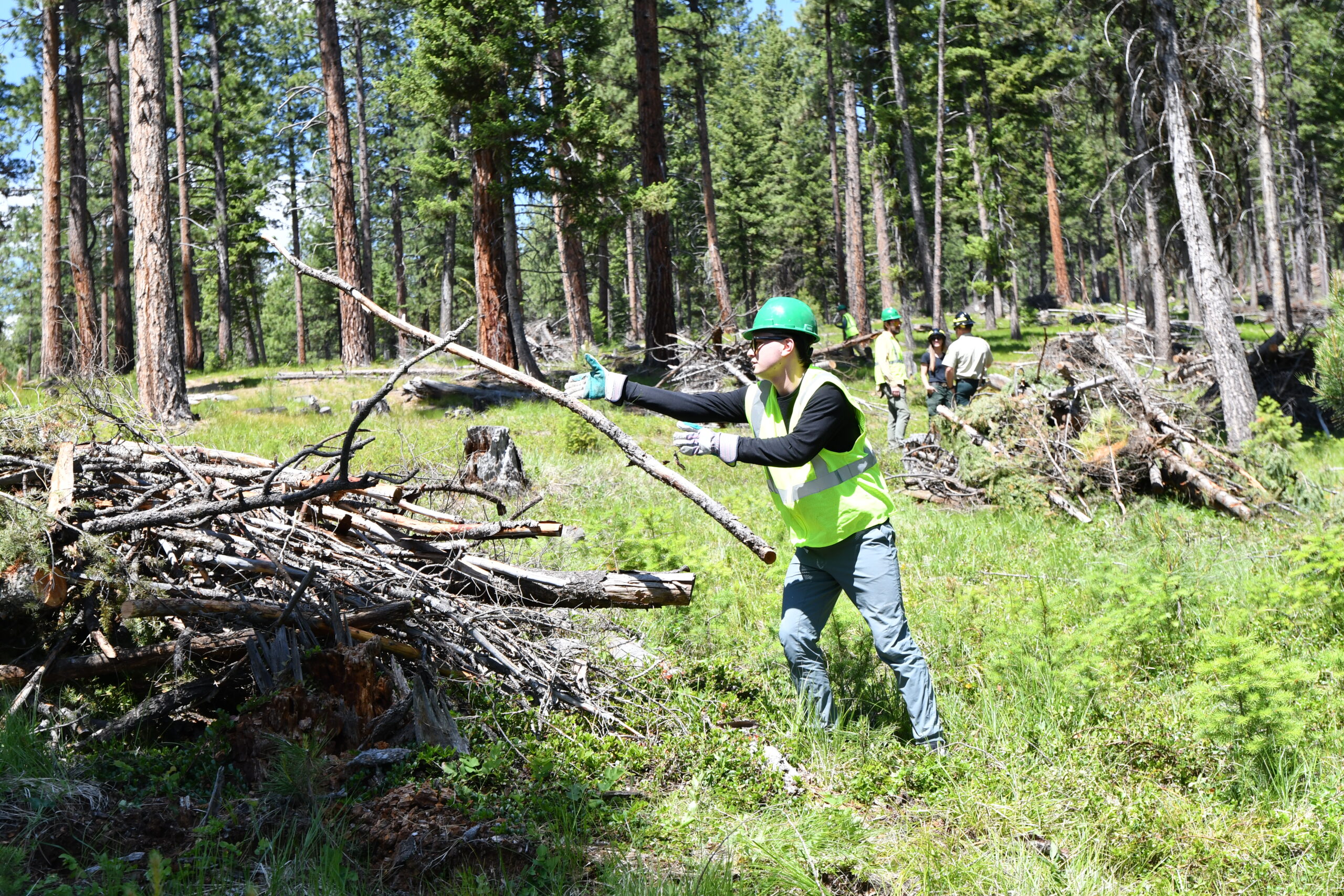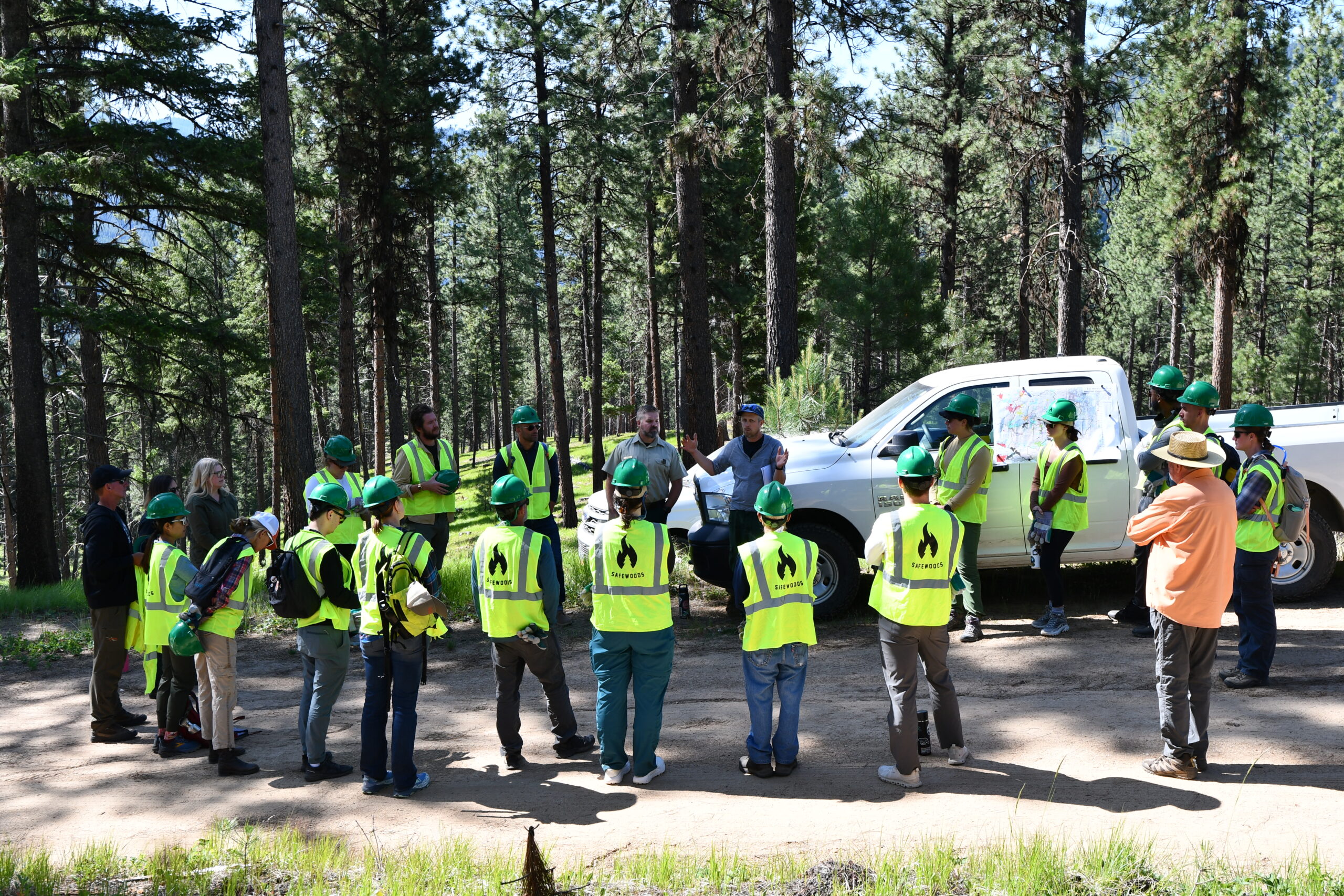
From Washington to the Woods: On-The-Ground Lessons for Wildfire Policy
Every day, I work on policy solutions to help end the severe wildfire crisis in North America. But that means I spend most of my time buried in my computer screen, poring over legislation and statistics—not in the field seeing the reality of the wildfire crisis unfold. There is a general disconnect between the DC wildfire policy bubble and those tackling wildfire on the ground in our public lands.
Just as we at the Federation of American Scientists strive to connect science and public policy, the folks at Safewoods strive to bridge the gap between what is being discussed in Washington and the reality of what it takes to implement wildfire resilience projects.
In mid-June, I joined a group of close to two dozen subject matter experts, retired and current wildland firefighters, philanthropic partners, and Congressional staffers representing states and districts from across the country for a stint at Safewoods. We gathered at the Safewoods site just outside of Darby, Montana, for three days to better understand the complexities of on-the-ground forest management – with the goal of incorporating those insights into our day jobs.
Wildfires are a natural feature of the forests around Darby, which historically experienced fire every 5 to 10 years. However, after nearly a century of misguided policies that placed outsized focus on fire suppression, the landscape has become choked with dead wood, shrubs, and other vegetation that can fuel natural fires into catastrophic ones.
Arriving and walking through the Safewoods grounds, I could immediately see the difference between that land and the untreated lands just outside the Safewoods property. The Safewoods team is returning good fire to the ecosystem by thinning or removing fuels that have built up. This creates space for beneficial fire to spread without becoming dangerous. Treated areas are easy to spot: there are trees of differing sizes and species, with plenty of space to grow. Enough light reaches the forest floor to nurture saplings, but not so much that the soil dries out.
Over the course of the three days, my colleagues and I learned from the Safewoods team about what it takes to do this restoration work, and how forest restoration complements other wildfire resilience practices. Mark Adams, Wildland Community Risk Reduction Specialist for the Flagstaff Fire Department, underscored the importance of home-hardening and scaling community risk reduction. Kelly Martin, the retired Chief of Fire & Aviation for Yosemite National Park, discussed how wildfire resilience yields co-benefits like improved water quality and increased fish populations.
A highlight of the trip was a hands-on forest management briefing and fuels management activity. After gearing up in long sleeves, pants, protective gloves and goggles, and our Safewoods-branded hard hats and vests, we set out into the Bitterroot National Forest, where U.S. Forest Service staff briefed us on how to build a small waste-biomass pile made up of the sticks, small logs, pine needles, and other waste material already pre-cut as part of an ongoing selective thinning project. Forest Service crews work to build these piles during the summer, then safely burn them in the fall or winter. Collecting and burning this excess vegetation restores forest health by promoting diverse tree species and density. Thinning and pile burning also lowers fire intensity and gets rid of fuel ladders that channel fire from the fire-resilient forest floor to the fragile canopy – making it safer to return regular fire to the landscape via prescribed or cultural burning.

Safewoods attendees receive a briefing from U.S. Forest Service staff on carrying out a selective forest-thinning project in Montana’s Bitterroot National Forest.
Our team worked for around two hours. The vegetation we were collecting felt light at first, but not long after getting started, I was sweating more than I do on my standard DC runs. At the end, as I joined others in catching my breath and downing water, we excitedly asked our Forest Service guides how many acres we cleared. They generously pegged us at about a half acre, causing us all to erupt in laughter about how little we’d actually done. But alongside the laughter we also acknowledged the sobering reality that restoring our nation’s forests is hard. Millions of acres of public land face high wildfire risk, but only a small percentage of those acres are receiving the labor- and time-intensive fuel-reduction treatments they need. The ultimate impact of our two hours in Bitterroot was not the half acre that we were able to clear, but rather the deeper appreciation we gained of the magnitude of the wildfire crisis, the hard yet necessary policy conversations we have to have around scalable solutions, and the resources we need to commit to build a fire-resilient nation.

FAS Wildfire Policy Specialist James Campbell clears hazardous fuels from the forest landscape as part of a hands-on experience at Safewoods.
Safewoods also fosters critical relationships across different groups of people working on wildfire. Smartphones are indispensable in DC, but lack of cell service at Safewoods meant that I was able to engage deeply with my colleagues in ways that are increasingly rare. No one was distracted by work emails or the latest breaking news; rather, we leaned into connecting around a shared sense of purpose. We sat around the fire hearing the crackle of the wood and laughing as each of us got our turn getting smoked out when the breeze shifted. We spent hours getting to know each other over meals and drinks and sharing why we work on fire. Some of us were always called to the outdoors, destined to be a forest manager or wildland firefighter; others (myself included) were too accustomed to city living for such adventure but nonetheless wanted to use their skills to protect our precious forests and the communities in and around them. No matter the reason, we came to learn about each other on a deeper level. We built trust that I know will pay off when it comes to navigating policy negotiations and executing cross-sectoral resilience initiatives down the line.
The communities and landscapes that have been devastated by megafires and the many more in high-risk areas do not have time to wait – they need meaningful solutions now. Confronting this crisis requires decision-makers to understand the lived realities of wildfire risk and resilience, and to work together across party lines. Safewoods helps make both possible.
This year’s Red Sky Summit was an opportunity to further consider what the role of fire tech can and should be – and how public policy can support its development, scaling, and application.
Promising examples of progress are emerging from the Boston metropolitan area that show the power of partnership between researchers, government officials, practitioners, and community-based organizations.
FAS supports the bipartisan Regional Leadership in Wildland Fire Research Act under review in the House, just as we supported the earlier Senate version. Rep. David Min (D-CA) and Rep. Gabe Evans (R-CO) are leading the bill.
The current wildfire management system is inadequate in the face of increasingly severe and damaging wildfires. Change is urgently needed